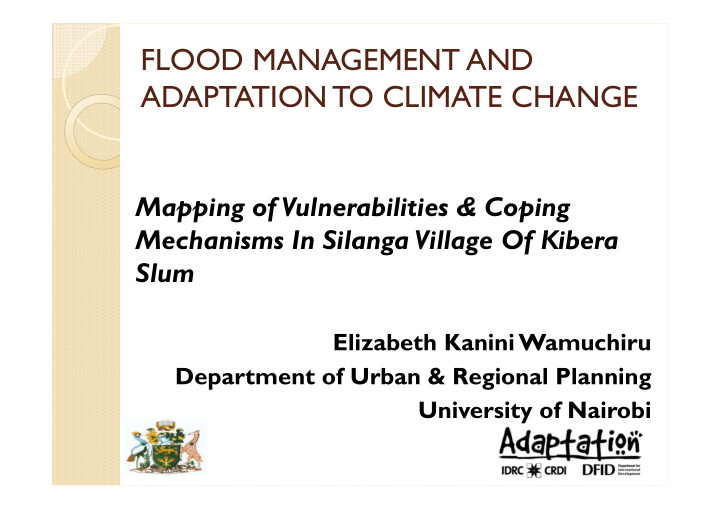



FLOOD MANAGEMENT AND ADAPTATION TO CLIMATE CHANGE Mapping of Vulnerabilities & Coping Mechanisms In Silanga Village Of Kibera Slum Elizabeth Kanini Wamuchiru Department of Urban & Regional Planning University of Nairobi
PRESENTATION OUTLINE � Introduction � Flooding Vulnerabilities � Climate Change Adaptation � Flood Coping Mechanisms � Mapping Of Existing Good Practices � Institutional Framework � Recommendations
STUDY OBJECTIVES � To assess the characteristics of Kibera informal settlements and extent of their vulnerability to flooding and ability to manage floods. � To establish and assess the existing adaptation strategies to flooding at institutional, community and individual levels in Kibera informal settlement. � To examine the roles of agencies and actors responsible for urban flood management in Kibera informal settlement and establish the level of local participation in its governance and decision making. � To design a framework for a sustainable adaptation and mitigation practice in informal settlements.
INTRODUCTION Kibera is the largest informal settlement in � Nairobi. Kibera is situated 7KM Southwest of the CBD � of the city of Nairobi Covers an area of approx. 223.2 sq.km. � Population is 355,188 people* � Density of 1,592 per KM square. � Land – Government owned � Inadequate services and poor conditions of � shelter 95% of residents are tenants � Kibera is made up of 14 villages � The study focused on one village: Silanga �
� Silanga had a population of 17,363 of whom 10, 198 were male and 7,165 were female. � Households number: 6,164 � Covers an area of 0.2sq.km � Density of 71,072 persons per sq.km Source: Kenya Census Report 2009
KIBERA SLUM IN NAIROBI CONTEXT
KIBERA SLUM
MAP OF KIBERA VILLAGES
MAP OF SILANGA VILLAGE
FLOODING VULNERABILITIES Settlement characteristics: � Overcrowding � Poor and hazardous structures � Narrow footpaths which are open trenches � Poor waste disposal practices � Poor building materials � Limited Roof catchment of rain water
Flooding of Mbagathi River which drains into Nairobi dam affecting Kibera residents Source: Sadique KI,2011
� Lack of awareness of climate change impacts on flooding. � Inadequate information and knowledge on climate related issues. � Inadequate capacities of the slum dwellers to handle flood. � Lack of flood disaster preparedness. � Inaccessibility to early warning systems and weather forecasts information. � No institutional framework at grass root level to deal with flooding.
CLIMATE CHANGE ADAPTATION � Settlement upgrading: standard low cost housing and building materials. � Invest in roof types that allow water harvesting. � Safer location of human settlement. � Provision of proper waste disposal facilities and services. � Promote use of clean energy e.g solar energy and biogas. � Reclaiming/salvaging the polluted Ng’ong river. � Subsequent rehabilitation of Nairobi dam. � Early warning systems and data availability.
FLOOD COPING MECHANISMS � Apart from periodic moving away from their houses during floods, the residents use the following local strategies: Use of mobile foot bridge Use of compacted soil bags Source: Author,2011
Use of barricade e.g concrete wall Possible intervention: Planting of vegetation along the drains Source: Author,2011
Use of sand bags Source; Sadique KI, 2011
MAPPING OF EXISTING GOOD PRACTICE � Flood control and management at the Silanga field and cleaning of the same. � Building of gabion along Ng’ong river to control flooding. � Unblocking of existing storm water drains � Construction of new storm water drains to drain surface runoff e.g at Silanga field. � Planting of trees and flowers to add vegetation cover. � Cleaning of the polluted river.
Before After clean up by KI Source: Author,2011
Cleaning of Flooded Field: KI Initiative Project Source: Author,2011
From a sea of garbage to a river. KI project. Source: Author,2011
Unblocking storm drains: KI Initiative Planting of Trees : KI initiative Source: Author,2011
INSTITUTIONAL FRAMEWORK � GOK formulated a Draft National Policy For Disaster Management In Kenya in 2009 to institutionalize mechanisms for addressing disasters. � Establishment of a National Disaster Management System (NADIMA). � Responsibilities of various committees, directorates & community level disaster management under NADIMA has not yet been worked out. � No coordinated policy framework nor legal basis for current disaster management system
CURRENT FLOOD MANAGEMENT IN KIBERA � It is spontaneous in nature for informal settlements Flood Response Institutions Include : � National Disaster Operation Centre � The Police � Department of Defense
� National Youth Service (NYS) � Fire Brigades � St. Johns Ambulance � Kenya Red Cross Society � Occupational Health and Safety Services � National Environment Agency (NEMA) � Provincial administration
INSTITUTIONAL WEAKNESS � Inadequate policy coordination in the institutional framework � Inadequate finances, human resources and equipments. � Inadequate information and data access � Weak disaster management capabilities within communities and institutions � Inadequate integration and coordination
RECOMMENDATIONS � Facilitation of accessibility to information and knowledge with regard to flood and disaster management � Integration of existing institutional framework � Building the capacity of local communities to prepare, respond and manage floods. � Develop the capacity of key institutions to plan and implement flood management activities in slum areas. � Managing water cycle as a whole. � Integrating land use and water management.
� Incorporate flood Risk Management Principles In Mbagathi River Water Resource Management. � Reduction of poverty through preventive & responsive strategies for the vulnerable slum dwellers. � Integrating flood risks management in the preparation of Development Plan for Silanga.
THE END THANK YOU!
Recommend
More recommend